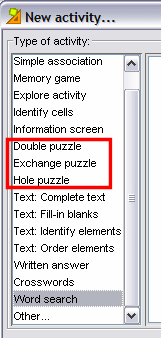-
Notifications
You must be signed in to change notification settings - Fork 19
JClic Guide: The puzzles
Puzzles
The puzzles are a type of activity where a graphical or textual content is presented out of order and which must be reconstructed in a logical way.
There are three types of puzzles: double, interchangeable or hole.
- The double puzzle has two panels on the screen. One shows the information but out of order, and the other is empty. This is where the content of the first panel is taken to put the information in order. The order in which the pieces are transferred is not important if the final information is in the correct order. To move the pieces of the puzzle you must click on one to select it and then drag it to the place it should go.

- In the interchangeable puzzle all the information is also out of order.The difference is that there is only one panel, and to reconstruct the puzzle you must change the pieces from one place to another until it is solved. As in the previous puzzle, to move the pieces you click on the chosen one and drag it to the appropriate place.

- The hole puzzle has only one panel where the pieces are out of order, plus one empty space. The content of this space, which the programme chooses at random, is the last piece to be put in place once the puzzle is solved. This content appears to the right of the space. The movements of the pieces are restricted .You can only move a piece which is next to the empty space, and so this makes the puzzle the most difficult of the three, especially if the content does not consist of images or if there is a large number of pieces. To move the pieces you only have to click on the one you have chosen and this will change places with the empty space which must always be next to it.

Making the puzzles
At the moment of creating a puzzle you must decide which type you want to do; double puzzle, interchangeable puzzle or hole puzzle.

Later on you can change the type if you want from the tab Options in the activity..
Whatever type of puzzle you decide upon, the options of the Panel will be the same.

The content of the puzzle can be graphics or text or a combination of the two. The graphic content is chosen using the button Image and the text content is introduced directly into each box..
The distribution of the panels can only chamge in the double puzzle because there is only one panel in each of the other two.
There are 4 options for the distribution of the panels the double puzzles. Panel A always corresponds to the pieces that have to be put in order and panel B to the solution. However, from JClic author and even though you change the option you will only see one panel. To see the effect of the different ways of distributing the panels you must open the activity in the test window.
 |
 |
When you make a puzzle you can also determine:
- The number of boxes by indicating the number of lines and columns that the panel should have.
- The size of the boxes. You must however take into account that if the content of the panel is an image, the size of the image will take preference over the size of the box.
- The shape of the pieces. You decide this when using the shape generator, details of which can be found in the document in this module: shape generator

In this puzzle, the four corner boxes have exactly the same content: the colour of the background. If you do not modify the image or change the number of lines and columns it will be difficult for the programme to accept that the puzzle is solved as these four pieces could be changed around indefinately.
It is also important to work on the image beforehand with a graphics editor to be able to have a correct sizing for the image. If the image is too large you can cut out the piece that interests you, or re-size it.
- User's guide of JClic
- JClic startup parameters
- How to make a CD-ROM with JClic activities
- How to translate JClic into your language
- JClic Reports Server with Tomcat and MySQL on Ubuntu
- Publish JClic projects on Internet with Netlify